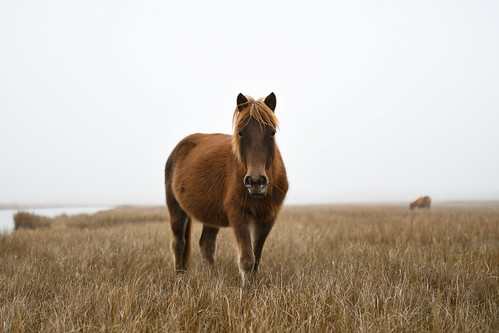#ProtectOurPonies: First Lady Yumi Hogan Joins Call to Protect Assateague’s Wild Horses
Each year, more than one million visitors cross the Verrazano Bridge to the narrow strip of barrier island that is Assateague, which is divided into Maryland’s Assateague State Park and the federal Assateague Island National Seashore. One of the major attractions here is the freely roaming herd of wild horses. Often referred to as ponies due to their small stature, these horses are actually more closely related to standard breeds and quarter horses. After years of living in the harsh barrier island environment, they have adapted by maintaining shorter, stockier builds that allow them to better navigate the unstable grounds of a marsh. Thick winter coats help protect them from strong ocean winds and the many insects found on the island.
Wild horses have occupied Assateague for about 350 years. Today the state park assists the National Park Service in managing the Maryland herd of approximately 80 horses. The parks provide neither veterinary care nor supplemental feeding as the horses are managed as a wild population. Unfortunately, humans feeding the horses or otherwise encouraging them to come near campgrounds and vehicles has left the horses unafraid of people and cars, making them more susceptible to dangerous situations on the Assateague roads.

First Lady Yumi Hogan reviews messaging signs to caution drivers about wild horses at Assateague State Park
A vehicle strike even at low speed can cause serious and even fatal injuries for the Assateague horses. Drivers traveling at night or in low light along park roads can have difficulty seeing the horses. Unlike deer, which may dart across the road, horses regularly stand completely still in the road, giving drivers little opportunity to react. In August, Maryland First Lady Yumi Hogan joined the Maryland Department of Natural Resources (DNR), Assateague Island National Seashore staff, and other guests at Assateague State Park, urging is-land visitors to drive carefully and “Give Wild Horses a Brake,” part of a new out-reach campaign designed to reduce horse injuries and #ProtectOurPonies.
“The ponies of Assateague are a treasure to Maryland and the nation, but it can be easy to forget that they are wild animals,” First Lady Yumi Hogan said. “I am pleased to see the efforts our Park Service is taking to help reduce harm. We urge drivers to be alert and observe the rules of the road and other park regulations to protect the ponies.”

The First Lady, Secretary Jeannie Haddaway-Riccio, Maryland State Senator Mary Beth Carozza, and members of the nonprofit friends group Assateague Alliance at the state park
“Our park staff and volunteers work hard every year to make Assateague Island a great experience for hundreds of thousands of visitors, as well as protect the wildlife that makes it so unique,” Maryland DNR Secretary Jeannie Haddaway-Riccio said. “We ask our guests to help us keep our wild horses safe for the continued enjoyment of this wonderful natural resource.”
The First Lady and Secretary Riccio reviewed new and ongoing efforts to help protect the ponies. Both the Maryland Park Ser-vice and National Park Service have invested in strategies to re-duce the risk for the horses. Assateague State Park installed four speed bumps and expanded crosswalks in the park campground, and placed highway messaging signs along the Route 611 causeway/park entrance road.
The State Highway Administration lowered the speed limit along the park entrance road across Verrazano Bridge to 25 miles per hour.
The National Park Service will add speed feedback signs displaying driver speed on the causeway and along Bayberry Drive and reduce speed limits to 15 miles per hour at several areas within the national park.
Visitors should also remember that close contact with the horses is also a danger to humans, as the Assateague ponies can bite and kick, and like most wild mammals, can carry rabies.
Park officials urge visitors to Assateague to follow these rules:
- Always stay at least 40 feet away from the horses and if they approach move away.
- Never touch, feed, or harass the horses.
- Keep all food, including pet food securely stored in a closed cooler with a strap or in a zippered bag (no open-top bags). Horses can open coolers and will get into bags with food, drinks, pet food, or trash—creating a potential health risk that could be fatal to the horses.
- Dispose of all trash properly—horses will eat plastic or even glass containers if there is food within them.
- Drive slowly and always be alert for wildlife. Follow all posted speed limits and, especially at night, go slow.
- Use only designated parking areas to view wildlife.
DNR created new handouts this year providing information for safely viewing horses and directing visitors who pull over along the causeway to use approved parking areas.

The Park Service is piloting campsite storage boxes like this one designed to prevent horses from accessing food.
Assateague State Park also hired additional seasonal rangers and reallocated staff and equipment—plus a team of two volunteer rovers—to conduct pony patrol activities, including: daily monitoring of where bands are located; documentation and updates on any incidents or items of concern; use of techniques approved by NPS biologists to move horses away from busy beach areas, roadways, campsites, and other areas where potential for horse/human inter-actions are likely; and other activities.
The Maryland Park Service is also piloting the installation of camp-site cooler storage boxes to prevent horses from accessing food. These boxes are modeled after those used in the national park campground, and staff are monitoring their effectiveness.
These ongoing efforts will keep Assateague Island safe for both wild horses and the people who come to enjoy seeing them.
Maryland Park Service Rangers Angela Baldwin and Claudia Padilla contributed to this article. Article appears in Vol. 24, No. 4 of the Maryland Natural Resource magazine, fall 2021.




